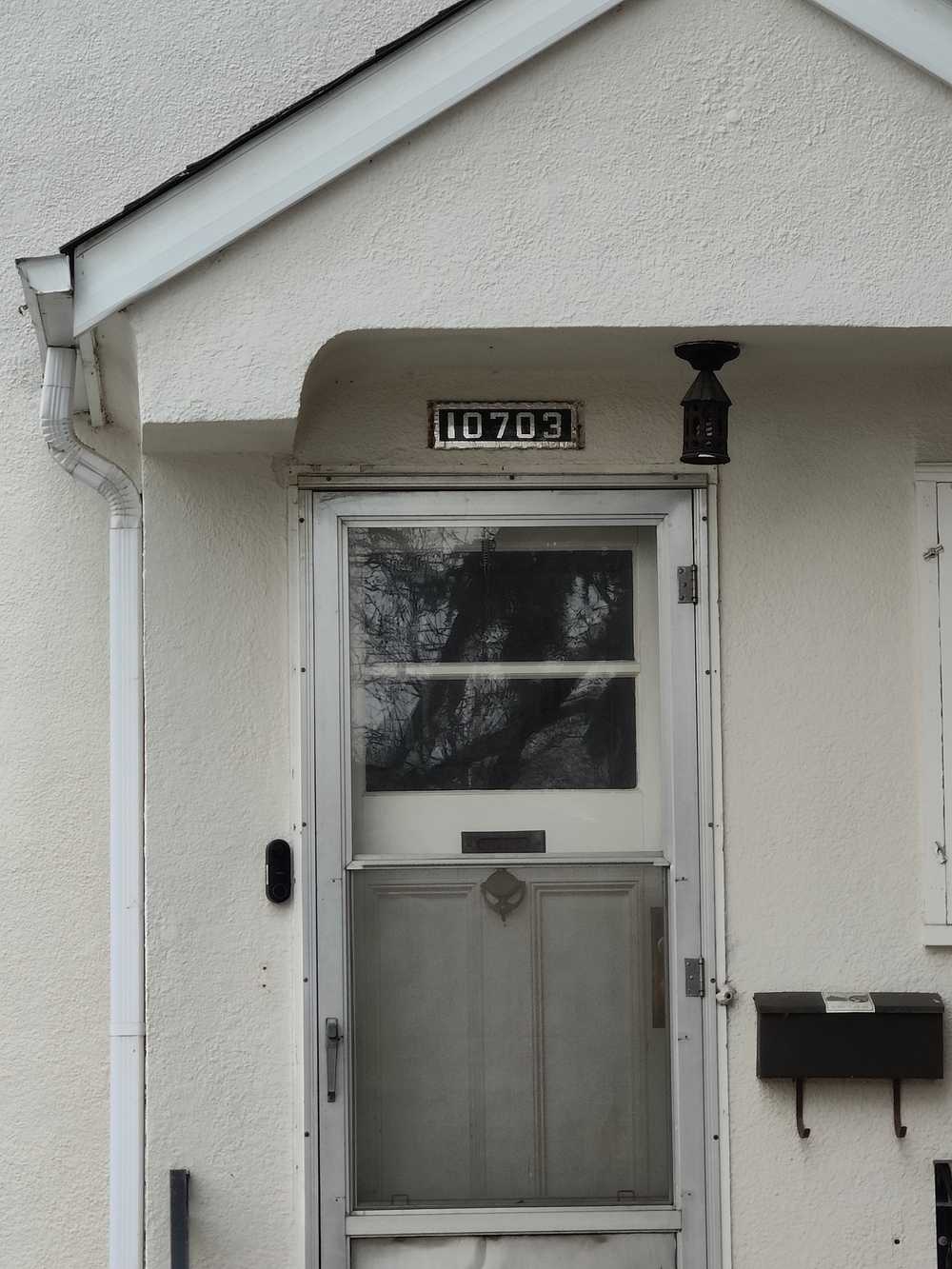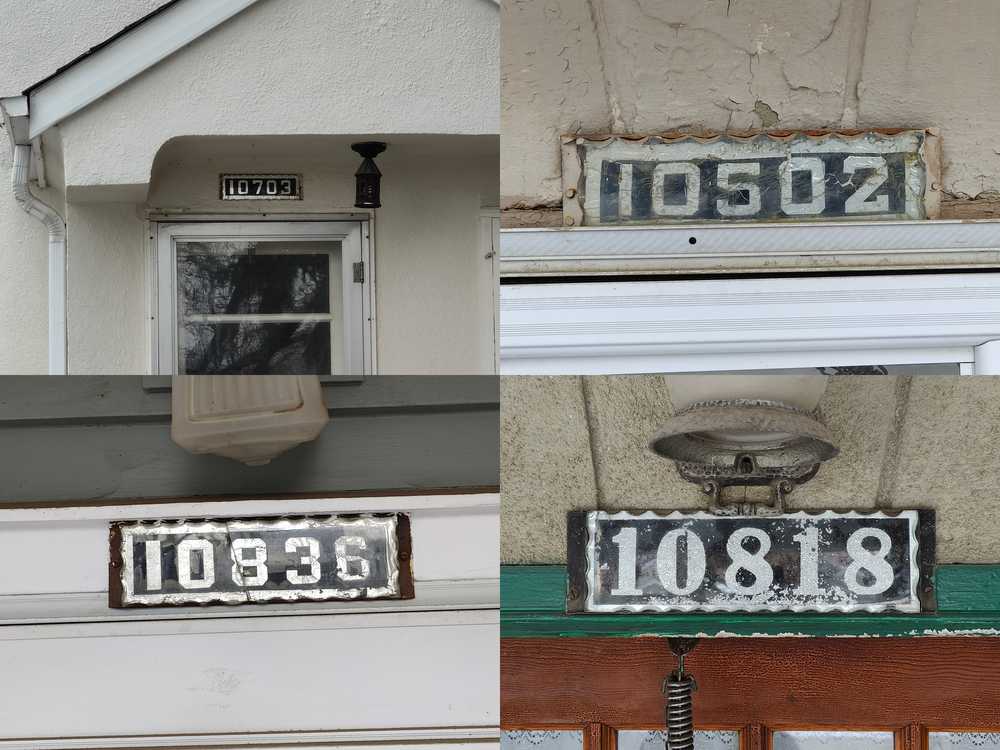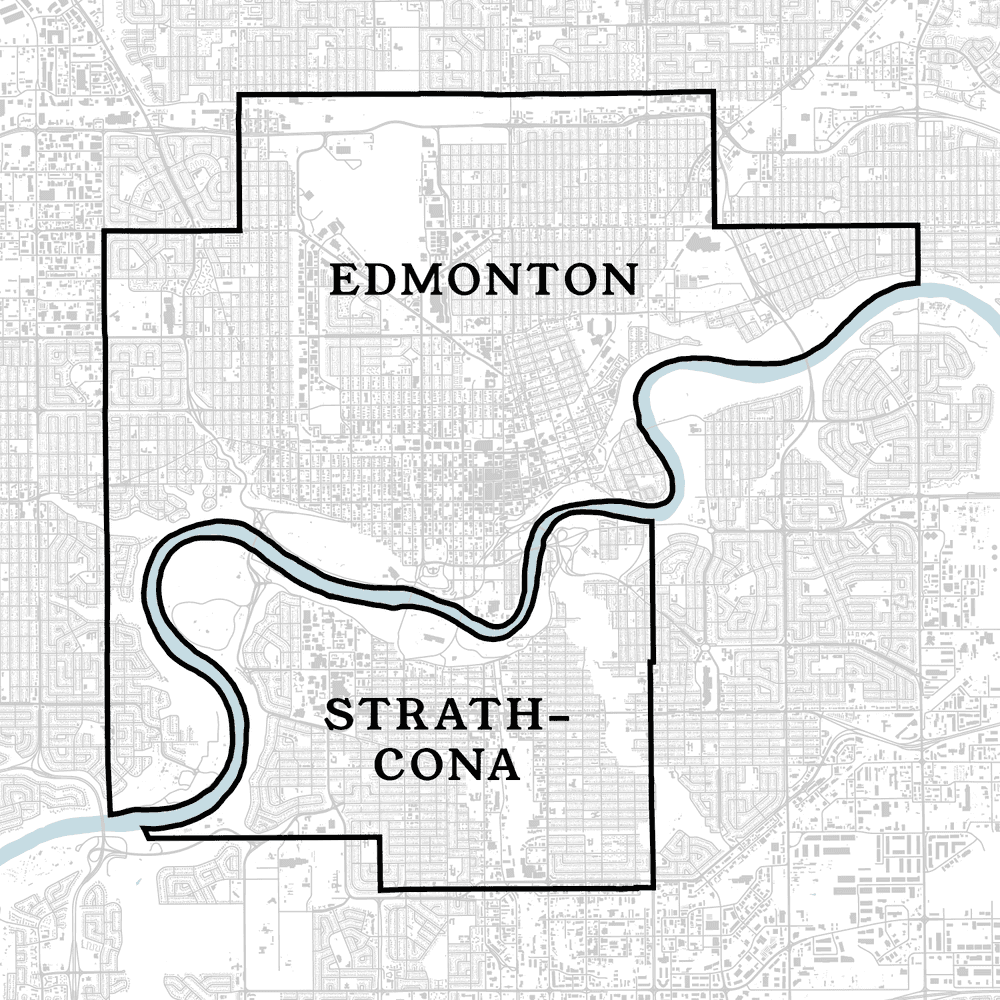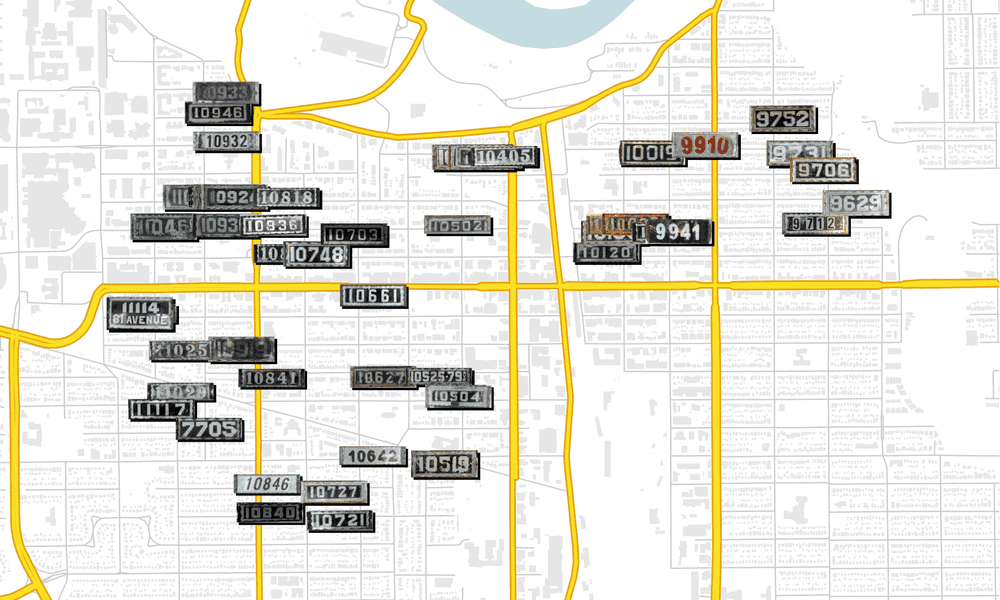At this point, I'm just thinking of starting a second blog called "House Number Hunter". This year, my holiday schedule took me to Edmonton, and my insatiable curiosity took me around a large swath of the city's historical Strathcona neighbourhood. Guess what: there will be photos and maps of an excessive number of original house number plates later in this post. Read on!
A little hypothesis
I have already written at great length about historical house number plates in Regina, where spending time in an older neighbourhood quickly revealed that the city only has one widespread old house number style, suggesting some kind of common origin. Is this the case in other cities? Well, I'm a cheap and restless person, and walking is free.
After about twenty minutes spent perambulating around the famous* Whyte Avenue, I noticed a worn-out old house number that caught my attention.
* By Edmonton standards.
After an hour on my feet, I had located four, all sharing some key characteristics:
- Nearly identical dimensions (small by modern standards)
- Usually displayed right above the door (an unpopular location today)
- Iron baseplate, foil, and glass construction
- A scalloped outer edge fixes the glass to the baseplate
- The foil layer is degraded with age
That's a pattern!
As much as I want to use my data science background to uncover lost secrets from Edmonton's past, let's briefly consider the null hypothesis: what if there's nothing really special about these house number plates, and they were just bought from a local hardware store? Importantly, I didn't spot any old numbers in other styles. I think it's safe to assume that these were once centrally issued for the Strathcona area.
This small sample raises a few unanswered questions. Although these plates all clearly share some kind of relationship, one of them has wildly different typography than the others, and its black coating seems to be disintegrating in an entirely different way. The tax records also indicate that every one of these buildings were put up in the 1940s, a full decade after standardized house numbers stopped being issued in Regina.
Before we revisit these points, let's go over a bit of local history.
The twin cities
Unlike Regina, a pancake-flat railway town which grew from an original nucleus with very little interruption, the addressing system in Edmonton was shaped by its turn-of-the-century politics. When Alberta entered the Canadian family in 1905, the deep valley of the North Saskatchewan River wound its way between the rival towns of Edmonton and Strathcona.
Long story short, Edmonton is the older one, growing up around a fur trading post - now currently occupied by the Alberta Legislature in the same fashion that some churches are built on top of Mesoamerican pyramids. Strathcona is an upstart railway boomtown, appearing south of the river a century later as the first tracks punched straight north from Calgary. Missing the train would normally seal the fate of any old prairie community, but Edmonton's nascent political establishment was able to rewrite history, and through treachery and intrigue the Legislative Building was awarded to the town north of the river.
In 1912, Strathcona was folded into Edmonton, and the result was a mess. The two cities had never co-ordinated their street names, and plenty of words were duplicated in different places. By 1914, the issue had gone to plebiscite, including a public contest with a cash prize of $100.
Ultimately, the public contest winner was ignored, and the winner of the plebiscite was Mayor Wm. Short's distinctive (and now familiar) plan to designate the heart of downtown as 101st Avenue and 101st Street. This is a pretty unusual strategy by North American standards, but because it sensibly avoids reduplicating addresses in the core, it was exported to most of Central Alberta. Thus was established the only place on earth where even the smallest towns generally begin at the intersection of 50th and 50th.
Assigning an arbitrarily high number to downtown makes sense, but if the goal is to avoid establishing a zero point in an inconvenient location, isn't this approach just kicking the can down the road for a few decades? Correct! Edmonton reached 0th and 0th in the 1980s, and was therefore forced to implement a quadrant system anyway, placing the entire existing city in the northwest. Most city residents only noticed this fact in the 2010s, when the first SOUTHWEST developments started coming onto the market.
In addition to being an interesting story of politics, public policy, and human folly, this little narrative gives us a very clear start date for old house numbers in the Strathcona area: five-digit plates cannot be from any earlier than 1914.
Heritage inventory
With the early results looking promising, I was ready to allocate a few mornings for walking around the Old Strathcona area at the turn of the New Year. A lot of low-rise apartments were put up around Whyte Ave in the 70s and 80s, so I braced myself for slim pickings in the heritage architecture department. Regardless, it only took four brisk outings to end up locating an even fifty plates!
I count 6,935 addresses in the area that I walked, so we are looking at a survival rate around 0.7% - indeed much worse than the 1.6% that I encountered in Cathedral (Regina's nice inner-city neighbourhood). But, statistics are statistics, and more observations are inevitable if you just keep walking. Or at least these are the kinds of platitudes I muttered to myself as I enjoyed Edmonton's typical -20° January weather.
Even before I was done walking, I noticed that there were a few different categories of old number plate in circulation. These four styles are quite different from the mainstream, and are therefore the easiest to identify:
Let's download the City of Edmonton's property assessment information and compare these categories to the recorded build year of each house.
| Category | Years built |
|---|---|
| Curved Sides | 1926, 1933, 1933, 1934, 1934 |
| Deluxe | 1900, 1912, 1915, 1932, 1933, 1946, 1946, 1947, 1950 |
| Modified | Irrelevant - no likely common origin |
| Serif | 1941, 1942, 1942, 1942, 1943, 1943, 1945, 1945 |
Two hits and a miss!! These are all small sample sizes, but the Curved Sides category seems tightly constrained to the Depression years, and the Serif category (the most distinctive of the bunch) seems very tightly constrained to World War II. Perhaps its different method of manufacture and noticeably lower quality are the result of wartime shortages? Only the aesthetically pleasing Deluxe category is completely unmoored in time, spanning pretty much our entire date range from 1900 to 1950.
This leaves a large slush pile of 23 very plain and similar house number plates, spanning a wide range of dates from 1924 to 1954. I have some thoughts about how to differentiate these as well, but the variations are much more subtle and I think this would be best left for later.
Next steps
In a few afternoons, I think we've conclusively proven that older houses in Strathcona do have a common original house number plate style!
Even worse, it's completely different from the original plate style seen and documented in Regina, which implies that we might turn up completely unexpected results with a bit of research in any larger Western Canadian city. Is this hobby going to ruin my life?
Date range: These plates cannot be any older than 1914, and they seem to have been issued into the early 1950s. When I'm back at my home computer, I need to do a bit of data work about building age frequency in the older parts of Edmonton. It's possible that the later plates were simply physically carried over from older properties, but I didn't spot as many obvious infills as I saw in Regina, and the Serif category is clear proof that these were being issued new into the 1940s.
Geographic range: Anywhere in Edmonton that was built before the mid-50s is likely to contain a decent population of old number plates. I used Google Streetview to confirm that some target buildings exist north of the river... which is where Edmonton's biggest downscale older neighbourhoods happen to be. Guess where I'm going next?
Survival rate: Either Old Strathcona has been more intensely redeveloped than Cathedral, or glass and foil are simply physically fragile materials that don't last as well. I suspect it's a bit of both.
Categories: I think my currently demarcated category scheme is pretty robust, but I want to keep an eye out for subtle differences in the typical sans-serif type that I haven't even attempted to analyze in this post.
Oddballs: What on earth is going on with the two plates that list the full address of their house, number and street name?? This seriously punctures the argument that these were centrally handed out by the city government.
Before I head home, my plan is to do some walking in the northern Highlands area, which has seen much less infill development than trendy Old Strathcona. I'll also be getting in touch with the City of Edmonton Archives, a useful amenity not available in Regina, to see if they can turn up any original documentation to support the trends I see on the street. Maybe I'll even find out how these plates were manufactured, and come up with some ideas for how I could reproduce them.
All of this will have to wait for a second Edmonton historic house number post. If you know anything about these things, or want to invite me over to your historical neighbourhood in a different Canadian city, please get in touch!






